Dedicated Short Range Communications (DSRC) is a data-only automotive communication protocol.
There are two broad categories of DSRC: Vehicle-to-Vehicle (V2V) communication and the Vehicle-to-Infrastructure
(V2I) communication. Typical or potential applications of DSRC include:
- Electronic toll collection
- Cooperative adaptive cruise control
- Intersection collision avoidance
- Approaching emergency vehicle warning
- Automatic vehicle safety inspection
- Transit or emergency vehicle signal priority
- Electronic parking payments
- Commercial vehicle clearance
- In-vehicle display of road signs and billboards
- Traffic data collection
- Rail intersection warning
- Blind spot warning
- Sudden braking ahead warning
- Rollover warning
DSRC communications are governed by the IEEE 802.11p standard. This communication protocol does not rely on access points but relies on direct communication between stations by forming a vehicular ad hoc network (VANET). Although no access point is present in 802.11p, there can still be fixed infrastructure stations (e.g., traffic lights) offering services to mobile stations (e.g., vehicles). In the U.S., the FCC has allocated 75 MHz of bandwidth at 5.9 GHz for DSRC communications. In Europe, 30 MHz has been set aside for vehicular communications at 5.875–5.905 GHz, solely intended for road traffic safety applications. Nonsafety-related applications are assigned a 20-MHz band at 5.855– 5.875 GHz. In Japan, the allocated frequency is 5.8 GHz. Generally, at 5.8 - 5.9 GHz, communication at data rates of 6 to 27 Mbps can occur at distances of several hundred meters.
An early version of DSRC (CEN-DSRC) is widely used for electronic toll collection (a V2I application) today; however V2V applications will not be fully functional until a significant percentage of cars on the road
are equipped with DSRC systems. In 2014, the National Highway Traffic Safety Administration (NHTSA) announced its intention to require V2V technology in all cars and light trucks sold in the U.S. [2]. A specific date for implementing this requirement has not yet been announced.
Forward Obstacle Detection and Avoidance: In this application
DSRC channel is used to communicate traffic information or accident warnings back through vehicles
to caution the drivers of a possible danger ahead. Communication with vehicles directly behind or
in front of an automobile can be used to enhance the functionality of adaptive cruise control systems.
Information passed from vehicle to vehicle can warn the driver of obstacles or road hazards
thousands of feet ahead.

Approaching Emergency Vehicle Warning: Vehicle to vehicle DSRC would
enable information about an approaching emergency vehicle to be relayed from vehicle to vehicle forward
through traffic. This would help to clear the way for the emergency vehicle and reduce the risk to other vehicles.

Cooperative Adaptive Cruise Control: This system is effective when the adaptive cruise control fails to perform correctly due to the radar's line-of-sight scanning. When the car approaches a sharp curve, the DSRC system warns the adaptive cruise control system of any slow moving vehicles just around the turn.

Pedestrian and Bike Safety: In 2013, Honda demonstrated the ability of a car equipped with DSRC technology to detect a pedestrian with a DSRC enabled smartphone [9]. A proprietary smartphone application determines the position, direction and speed of the pedestrian and, using DSRC technology, the position of surrounding vehicles. In the event of an impending collision as determined by the smartphone application, the system alerts the pedestrian via a repeating, high-volume beep and a warning on the screen of their smartphone. At the same time, the system alerts the driver to the potential collision with an audible alarm and visual warnings on the vehicle's heads-up display and navigation screen. In addition to the basic safety warnings, the vehicle can also receive information on whether the pedestrian is texting, listening to music, or on a phone call.

Hazardous Driving Conditions Warning: DSRC systems can also be used to monitor adverse weather and hazardous driving conditions. In V2I systems, weather stations can send information to the traffic agencies, who can lower speed limits and send warnings to drivers. In V2V systems, cars who experience a loss of traction (due to water or ice), can send warnings to other cars in the area.
While V2V DSRC systems are still in their infancy, much is being done to develop them.
In Europe in particular there are collaborative research projects to further develop every level of the
system from in-car hardware and software to infrastructure. Many of the large automakers of the world
are also developing DSRC systems including: BMW, Daimler, Ford, GM, Honda, Mitsubishi, Nissan, Toyota, Volvo,
and Volkswagen.

